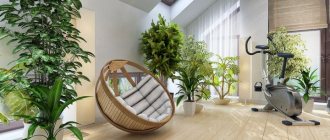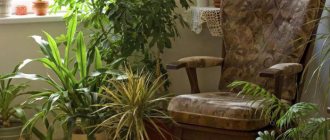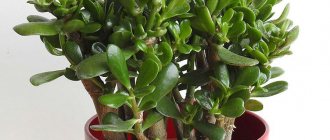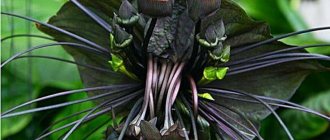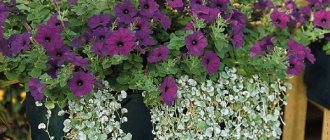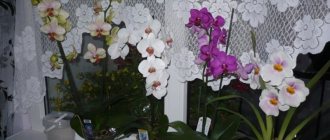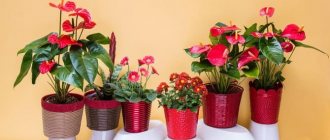Indoor flowers as part of the interior
When designing a living space, it is worth noting that the design should not only please the eye, but also provide comfort. The arrangement of flowers in the interior of the apartment should be organized so that the room is not cluttered, but its advantages are emphasized. An interior with flowers in an apartment looks more comfortable and has undeniable advantages:
- an abundance of greenery relieves eye fatigue and helps you relax after a hard day at work;
- fresh flowers regulate humidity and purify the air;
- plants can optically change the proportions of a room.
It doesn’t matter whether you use fresh flowers in the interior of your home or use artificial analogues, you must adhere to the recommendations listed below. Plants, regardless of their origin, must:
- correspond to the dimensions of the room;
- combine with existing furnishings and decoration;
- harmonize with the color scheme and the general concept of interior design.
Important! Owners of miniature rooms should take into account that a composition containing large plants in the background and smaller ones in front of them creates the illusion of perspective and visually expands the space.
Indoor plants in the interior of a house/apartment
Types of landscaping
Despite the fact that there are many options for decorating a home using plants, landscaping is divided into two main types:
- vertical and
- horizontal.
Vertical
Flowerpots are placed on vertical posts, shelves, flowerpots and walls of the house. As a result, horizontal surfaces are not loaded, and if the decor is on the walls, they do not take up space.
- Wood, metal (forging), and strong wicker weaving are used as materials for structures.
- Indoor plants in the interior can form an interesting composition (group).
- You can also place one large planting in the structure, especially if the area of the room is small.
Phytostena
The current design solution is a phytowall. Green spaces occupy the entire wall or most of it. To create a wall, a frame is built, which is filled with fertilized soil. Seedlings are planted throughout the area.
You can set up a phytowall both outside and inside the room.
It should be remembered that this is a complex design that requires a professional approach. Plants that occupy the entire area of one vertical surface will look out of place in the interior of a small apartment. The best option is spacious premises, offices, public places. As an option, you can make a phyto-painting in a small room. The protruding green part is framed in a baguette.
Horizontal
This type means the classic arrangement of flora on horizontal surfaces: shelves, racks, window sills, tables of different types and sizes. This solution does not require the construction of additional structures and complex installation. However, the pot should match the style of the room.
Designers suggest diversifying this method by integrating greenery into the furniture. You can use a glass coffee table, chest of drawers, shelf. Then decorative plants in the interior will look impressive and original.
The horizontal type, of course, has its disadvantages:
- the usable area becomes smaller,
- with an abundance of flora, the room can look cluttered.
What should you consider when decorating your interior with plants?
There are 4 main criteria:
- Functional purpose: - part of the decor, - air purification, - masking defects (scuffs on the wall, cracks, etc.).
- Size of the room and flora.
- Room temperature.
- Degree of illumination.
Plants in the interior of rooms
When choosing floral decor, take into account the purpose of a particular room. Let's look at each part of the house in more detail.
- Hallway
The key limiting factor is insufficient lighting. In addition, apartments do not always have large hallways, so there are few options for design imagination.
Representatives of the flora that are unpretentious to natural light are suitable for this part of the home:
- monstera,
- anubias Gillet,
- ferns.
It is best to place them near a window or closer to a light source. In a large and bright hall, it is advisable to place large flowerpots on the floor. Most often, designers use greenery with a tree trunk and palm.
If the hallway is dark, artificial plants are suitable as decoration. Despite many prejudices and signs, they will look impressive with maximum imitation of natural ones.
- Living room
In this part of the room you can implement many interesting ideas. Living rooms are usually large and bright, so flora can be large and blooming profusely.
- The main part of the home will be decorated with monstera, dollar tree, palm tree, fiery vriesia, anthurium, ficus.
- Small plants are grouped together, while large plants are placed separately.
- Compositions are made using flowerpots, shelves, window sills and suitable furniture.
Lianas in hanging pots or in ordinary ones would be appropriate if you use the stems to create an interesting composition using a frame. For example, insert arcs into a pot and entwine them with a vine, or install a frame in the shape of a pyramid.
A climbing plant called epipremnum is widely used in home interiors. It looks attractive, lends itself well to design techniques, does not require special care, and grows quickly; and most importantly, it cleans the air very well. You can use it to make a phytowall in the desired shape, or you can give it the opportunity to grow freely from a hanging pot.
If the living room does not connect to the bedroom, purchase indoor flowers that emit a pleasant aroma. The main thing is that he is not harsh and that you like him. In most cases, the color of flowers will be advantageous: an effective contrast for a room in pastel colors and emphasizing the rich color scheme of the room (close colors of flowers and the room).
- Kitchen
The kitchen is characterized by temperature fluctuations, high humidity, and evaporation.
- Plants in the kitchen interior should be unpretentious and resistant to the listed factors.
- Balsam, blooming luxuriantly with soft pink inflorescences, geranium, if you like the smell, or unpretentious aloe are suitable.
- We would like to especially mention the epipremnum. As mentioned above, it does not require special care and absorbs harmful fumes, purifying the air. You can use it to create a phyto-picture, a phyto-panel, a phyto-wall, or place it in a hanging flowerpot.
Due to the fact that there are already a lot of functional items in the kitchen, to save and unload space, it is optimal to place green decor in the form of wall or hanging compositions. Climbing plants can take up space on hanging kitchen cabinets.
To ensure that the flora retains a presentable, fresh appearance, do not place it near the stove or near fumes. The latter often settle on the leaves, even if the flowerpot is at the optimal distance from the stove. Therefore, do not forget to regularly clean the foliage using a clean, damp sponge or cloth.
- Bedroom
It must be taken into account that at night the “lungs of our planet” absorb oxygen, and during the day they release it. Avoid an abundance of flora in the bedroom, especially if you have vegetative-vascular dystonia or low blood pressure.
However, there are greens that release oxygen at night: kalanchoe and aloe, which are useful because their extract heals skin damage, rejuvenates, and has a beneficial effect on health.
If hot rays do not come through the windows, place violets on the windowsill. They do not take up much space, radiate tenderness and do not smell. Spathiphyllum with delicate white, odorless flowers is also suitable. In a large bedroom, place a medium-sized decorative tree in a tall floor pot, such as a monstera or palm tree, in a bright corner.
You need to be careful with flower scents for the bedroom. To ensure a restful, sound sleep, and an easy awakening, eliminate floral aromas or at least reduce them to a minimum.
- Children's
Natural decor is successfully used in children's rooms. It is important that it not only fits harmoniously into the environment, but is also safe.
- Hanging representatives of the flora out of their reach are suitable for children.
- It is advisable to avoid cacti, as well as strongly smelling plants.
- In the room of older children, you can place flowerpots on the windowsill or floor. For example, a large palm tree will perfectly complement pirate motifs, and tropical vegetation will complement marine ones.
Living decor is also ideal if it makes a positive impression on children and has a calming effect. In a nursery, fern, adiantum, and cyclamen are appropriate.
Useful design tips
- It is important to choose the right not only flora, but also pots. An ordinary sansevieria will be transformed to its advantage if it is planted in a silver or golden pot.
- The container is made in a style that is in harmony with the decor.
- For variegated plantings, one-color or two-tone containers; for one-color plantings, a color combination is possible.
- Flora that blooms in certain seasons will be highlighted all year round by a container with a beautiful ornament or convex pattern.
- Place orchids only in transparent pots so that they do not disappear due to lack of lighting of the roots.
- Sansevieria in a white or black pot, money tree, and ficus are well suited for loft or high-tech. The container can be in the form of a wooden box for a loft or a geometric, cosmic shape with a metallic sheen for hi-tech. Less details, more simplicity.
- Provence style is emphasized by containers of light, lavender colors. The pot can be decorated with textiles. Flora with purple, white and soft pink flowers.
- In classic Russian wooden houses and mansions, painted flowerpots (Gzhel) look harmonious. Flora: ivy, geranium, impatiens.
- For classic homes, traditional decorative flora with lush leaves and straight growth is suitable. Graceful azalea, camellia, and begonia are suitable.
- You can enhance the perception of the composition by using backlighting or spot lighting in the desired area.
✽ ✽ ✽
Indoor plants in the interior of the house not only harmoniously complement the monastery, but also bring health benefits. Don’t be afraid to experiment with compositions, add greenery to your home, and comfort will definitely stay with you for a long time!
Fresh flowers in pots
Real greenery placed in the room will be a win-win for those who like plants and are willing to care for them. Unpretentious dracaenas, delicate orchids, popular ficus and palm trees have become familiar neighbors in our residents. When placing fresh flowers on the wall in the interior, on shelves or in the window area, consider the following recommendations:
- Don't settle for the traditional option of placing plants using a window sill. Create compositions using stands, racks, and place pots directly on the floor.
- Do not make compositions from traditional and fashionable house plants. For example, “grandmother’s” violets can easily be replaced with azaleas.
- When creating a floral interior in an apartment, pay attention to the colors of the pots. They should be combined with each other, in harmony with the interior. A win-win option would be delicate pastel colors that will fit perfectly into any interior.
Saving flowers from underfloor heating
Warm floors, which have won the hearts of many interior designers of apartments and especially private houses, can damage your flowers standing on the floor. If you use such a modern achievement in your room, then raise the flowers a few tens of centimeters so that the warm floor does not dry them out. It is also advisable to use air humidifiers, which will help maintain moisture in the room, which will certainly please both the plants and even you. An original and modern way to raise flowers above the floor is to use floating pots.
Floating flower pots. Photo: ladytech.ru
Artificial
Artificial greenery will be a wonderful solution for those who want to diversify their interior, but do not have the opportunity to fully care for living plants. When composing compositions, do not occupy all the window sills and corners with pots, use your imagination. For example, artificial flowers on the wall will look original. Before you start, read the advice of professionals:
- An arrangement of artificial plants will look great on a coffee table - it doesn’t need a lot of light, and the covering won’t deteriorate, since they don’t need to be watered.
- Tall flowers look great in floor vases. This solution will be an excellent decoration for the living room or hallway.
- Artificial climbing plants can be beautifully placed on the wall. They will not deteriorate from lack of light, they will not have to be sprayed, which will help preserve the finish.
Large
Large flowers in the home interior feel great in spacious, free areas. They will be a wonderful decoration for rooms equipped with floor-to-ceiling windows. Species whose size exceeds 1.5 meters are considered large. Individual plants can reach the ceiling.
Large flowers can be placed separately or become part of a composition with smaller counterparts. Such ensembles are an excellent solution for recreation areas, as they can create a unique atmosphere for relaxation. When planning to use such options, consider some nuances:
- You should not place large plants on windowsills - they will look bad there and lack light;
- flower pots play a big role; they must be in harmony with the decor and fit into the design concept of the room;
- large plants with a spreading crown will optically enlarge the room, tall specimens will visually raise the ceiling.
Fashionable
Today, randomly arranged flowers in a room, the interior of which is created with the latest fashion trends, are replacing stylish compositions. Miniature vegetable gardens located on the wall or on the windowsill and florariums are popular. Predatory flowers, rare exotic plants, and giant specimens will bring a special flavor to the room.
Large-sized trees will help you create a home greenhouse: dracaena, palm, coffee tree. Floor planters for flowers in the interior help to visually change the configuration of the room and hide imperfections. If you line them up in a row, you get a hedge that allows you to separate functional areas.
Using florariums (aquariums for plants) it is easy to create a miniature garden that will allow succulents, orchids, and ferns to thrive.
Beautiful indoor flowers
Home flowers in the interior should not be the result of impulsive purchases. When planning to purchase them, it is worth thinking through the compositions in advance and taking the choice of copies seriously. In addition, it is worth assessing the compliance of the chosen location with the plant’s habitat conditions and its functional significance.
Most plants will look beautiful only with sufficient lighting, this should be taken into account when purchasing, arrange the flowers so that they receive enough sun or organize additional lighting, which is associated with costs.
For kitchen
Flowerpots in the kitchen interior will allow you to diversify the design and create accents that are pleasing to the eye. Many plants can easily coexist on the windowsill, from the usual violets to exotic ferns.
A feature of the kitchen is temperature changes and high humidity. It is worth selecting plants taking into account these parameters. Such conditions will provide excellent habitat for:
- aloe;
- ficus;
- ivy;
- miniature fruit trees.
When planning your kitchen design, keep in mind that plants should be organized and look neat. They can be placed directly on the table instead of cut ones. Flowers should look healthy and free of pests. Sharp, intoxicating aromas are unacceptable for this room.
For the bedroom
You can use a wide variety of pieces to decorate your bedroom. Plants are easy to place on the floor, window sills, or create a composition on a wall, bedside table, or coffee table.
Since the bedroom is a place for relaxation, where we spend a lot of time, it is worth avoiding species whose representatives are capable of releasing toxic substances. This will lead to constant headaches and malaise. You should not choose flowers with a rich aroma. Also, experts do not recommend using lilies, which actively absorb oxygen, to decorate the bedroom. The ideal option for the bedroom would be:
- spathiphyllum;
- violet;
- myrtle;
- Kalanchoe.
When choosing an option for the bedroom, you do not have to worry about the opinions of guests, since they rarely visit this room. You can create a composition to your taste and enjoy it.
For dark rooms
If the apartment is located on the north side, its windows are covered with tree crowns, choose plants that can easily tolerate shade. Decorative foliage options tolerate darkening perfectly and will decorate a room shrouded in twilight.
It is easy to place such a composition in any convenient place. Can be placed on a windowsill, placed on a wall or on the floor. Experts note shade-loving plants that have become popular:
- philodendron;
- fern;
- scindapsus;
- aglaonema.
When choosing a shade-loving specimen, keep in mind that it can be located on a windowsill if it is not exposed to direct rays of the sun. Depending on the lighting, the green pet can be placed at a distance of 3 to 9 meters from the window. A standard apartment can provide maximum distance from bright light by placing the plant at the end of the hallway or bathroom.
For the bathroom
Taking water treatments surrounded by living plants is doubly pleasant. Specimens that prefer darkness and high humidity will get along well here. If there is no window in the bathroom, you will have to periodically take the plants out into the light and add additional lighting. The following plants will be comfortable in the bathroom:
- tropical species;
- fern;
- ficus;
- chlorophytum.
Important! The bathroom is a place that is undeservedly forgotten by lovers of house plants. A miniature room can be decorated with small plants located on shelves. If you have an impressively sized bathroom, diversify the regular shapes with an exotic tree in a tub.
In the living room
Flowers in the living room will be an excellent solution when it is quite free and not overloaded with various furniture. Having opted for large specimens, such as dracaena, yucca, it is easy to optically further expand the space.
By choosing hanging plants, small perennials, as well as climbing and weaving options for the living room, you can create a comfortable, cozy atmosphere in the room. When arranging the composition, take into account the characteristics of the plants, moving the light-loving ones closer to the light source.
In the hall
Species that are able to develop even with a lack of light will be comfortable here. Plants should have strong leaves, insensitive to constant touching, and lush bushes. It is important that the pots in which the flowers are placed are low and heavy, resistant to tipping over.
Ficus, fern, Hederes ivy, and cissus will be luxurious decorations for the hallway. However, even such shade-tolerant plants need to be periodically moved to a sunny place. Otherwise, they will lose their decorative effect and die. An alternative option is to use artificial greenery.
How to Place Outdoor Plants
- Outdoor artificial plants for home interiors should be placed in a large flower pot. A small pot that is “not the right size” reveals the artificiality of the tree, because it does not correspond to its dimensions.
- Tall, single plants are most often placed on the floor. Paired large-sized ones in identical flowerpots, standing symmetrically on both sides of a door, window or showcase, look impressive.
- You can create compositions from floor planters of different sizes, but of the same style, shape, and color. To ensure that all plants are clearly visible, make the group multi-level. For the back row, you can use flowerpots of different heights or columns.
- In flowerpots in the form of tall cones, cylinders, trapezoids and dividers, artificial hanging flowers with flowing leaves (for example, chlorophytum, ferns) look beautiful.
- Outdoor artificial plants are often used for street landscaping - they decorate balconies and loggias, terraces and lounge areas, the territory of restaurants, hotels, and shopping centers.
- Large trees and bushes do a good job of zoning space and allow you to adjust the architecture of the room. With their help, you can stylishly disguise unsightly communications and repair defects.
In the photo: Artificial palm tree in the living room
From us you can purchase designer floor planters and artificial plants of first-class quality. The catalog presents the widest range of products from the Belgian brand TREEZ at attractive prices.
Where to put flowers in an apartment: tips
When starting landscaping, keep in mind that plants must be placed taking into account the peculiarities of their care and design rules. When choosing a place for permanent habitat, study the conditions that will be optimal for its development.
Flowering specimens often prefer a well-lit area; ferns and representatives of the dracaena family can thrive in shaded conditions.
How to place flowers on the windowsill?
The window sill remains the most common option for placing plants. Windows facing south, west or east are best suited for this. The north side will be a good solution for greenery that prefers shade.
The south side, constantly illuminated by bright sun, is an excellent option for succulents, cacti, oleander, and roses. On the western side, citrus fruits, tradescantia, and coffee will be comfortably located. Eastern - will become a cozy place for azaleas, dieffenbachia, fuchsia, and bulbous ones.
Placing flowers on the floor
Natural greenery will thrive on the floor as long as it is tall enough and receives the right amount of light. A large, heavy pot will make the flower unsafe if placed on a table or windowsill.
The best solution to place the plant on the floor is when purchasing decorative dwarf trees or tall vines. By placing them symmetrically near the door, you can add symmetry to the room, making them a group - moving part of the garden into the house.
Placing plants on a stand
Flowers with hanging branches and curved leaves deteriorate when placed on the surface of a windowsill, cabinet, or shelf. Their decorative effect is revealed only when using various stands. Hanging containers and floor structures allow you to create compositions in any part of the room.
When choosing an option for placing greenery, keep in mind that they can be:
- in the form of a miniature table on a leg;
- speakers made of wood, metal, smoky glass;
- rod holders made of forged metal, plastic, wood;
- grilles that help divide the room into zones.
Placing flowers on the walls
The wall turns into a green zone when it is necessary to create a bright accent in the room and give it individuality. To keep the air moist and not spoil the finish, select deep vessels equipped with a capacious tray.
Flowers in the living room, the design of which you plan in advance, should be in harmony with the surface on which they will be placed:
- Lush greenery and bright flowers will look great on delicate, pastel surfaces. Plants with variegated leaves and numerous pale flowers will be lost against such a background, but will look great on a dark wall.
- Avoid specimens with small leaves if you choose a wall with a small pattern as the background. Species with large, spreading foliage will look great on it.
- Combine contrasts and shapes. A strict vertical pattern will enliven a luxurious climbing plant.
Types of outdoor plants
The assortment of outdoor flowers is very large - usually such plantings are purchased ready-made or grown independently and in stages. The size of plants of this type makes them more noticeable in comparison with miniature flowers on the windowsill. Along with the size, the benefits also increase: many similar species have numerous or very large foliage that release a lot of oxygen. The most popular outdoor plants can be divided into the following groups:
Palm trees
Representatives of this group naturally live in a humid and warm climate, so it is recommended to create similar conditions for them at home. The height of such plants can be quite impressive.
Hovea
This Australian palm is often called ideal for growing in an apartment. In the natural environment, howea grows up to 15 m in height, but at home the maximum size of such a palm tree is only 2 m. Howea does not require special care and does not need to maintain a high level of humidity, although occasionally it can still be sprayed. These palms are grown in a nutrient substrate in floor pots or tubs. Watering is carried out as the top layer of soil dries.
Rapis
This palm from Southeast Asia is also unpretentious. You can keep the tub with it in either a semi-shaded or sunny corner, but to form uniform foliage and a symmetrical crown, it is important to regularly turn the palm tree in different directions towards the light. The maximum size of domestic specimens is 3 m in height. In hot weather, it is recommended to spray and water rapis more often, trying to constantly keep the soil slightly moist. There is no need to over-moisten the earthen ball. In winter, the plant will need less moisture, so watering will have to be reduced.
Lianas
Not all vines resemble graceful grassy ivy or bindweed - sometimes among them there are real giants, turning tropical forests into impenetrable thickets.
Monstera
This plant justifies its unusual name with its size. Even at home, its shoots can reach up to 5 m in length. No less remarkable is its large “torn” foliage up to 45 cm long. Monsteras are heat-loving, so they should spend the winter in a room where the temperature is at least 16 degrees. The vine will also require a lot of diffused light, moist soil and strong support. It is also recommended to direct the aerial roots formed by the vine into a pot.
Scindapsus
This vine is also known as epipremnum. Its difference is its very rapid growth, up to 1.5 m per year. The heart-shaped leaves of the plant can be a single color of bright green or be variegated. To grow scindapsus you will need a semi-shaded corner. The plant is not too picky about the temperature in the room, but reacts sharply to overwatering. Stagnation of moisture at the roots of the vine quickly leads to its disease, so watering is carried out only when the soil dries out.
Syngonium
This liana prefers moist soil, as well as regular spraying. Its leaves are also heart-shaped. The large green mass of syngonium requires reliable support. For the vine, choose a slightly shaded place - it does not like direct light.
Flowering outdoor plants
In floor tubs, not only crops with decorative foliage are grown, but also beautifully flowering plants.
Hibiscus
This plant is also known as Chinese rose. Beautiful large hibiscus flowers can have different colors: orange, red, pink or white. An adult shrub at home reaches up to 2 m in height, in nature - up to 3 m. If you provide it with proper lighting and timely pinching, the hibiscus will bloom profusely every year. This plant is undemanding in terms of soil composition, but requires regular watering and requires adherence to seasonal temperature conditions. Hibiscus can be propagated both by seeds and cuttings.
Abutilone
Due to the shape of the foliage, this plant is also called indoor maple. The height of domestic specimens is about 1.5 m. “Maple” blooms in spring and autumn, but if kept in a room where the temperature is no more than 15 degrees, the plant can bloom in winter. Abutilon requires a lot of light, and in the summer heat - abundant watering and systematic spraying.
How to choose indoor plants for your home
Greenery allows you to refresh the interior and give the home comfort. Before you make a purchase. It is worth planning what plants you will purchase and where they will be located. Thanks to the variety of types, you can choose an option that will fully match the interior and emphasize its individuality. For example, in a room decorated in a high-tech style, specimens with large, regularly shaped leaves will look great. In addition, it is worth taking care that the conditions in the room are appropriate.
Photophilous
Most flowering plants are considered light-loving. To force buds, they need a sufficient level of lighting, otherwise they will bloom less often and not so abundantly. When choosing options for landscaping a sunny window, it is worth considering where future pets grow in the real environment.
It is easy to identify light-loving species not only by their fleshy leaves or the presence of spines. They often have bright, decorative leaves, the color of which consists of two or more colors. It is worth noting that by placing them in the back of the room, you will not lose your green friend, but its decorative effect will disappear.
Shade-loving
Shade-tolerant specimens are much more difficult to select, but they are easy to care for and thrive in a darkened room. The popularity of creating flower arrangements on walls and special stands is growing, so we have to be stricter in the selection of plants that can withstand the proposed conditions and remain an interior decoration. The illumination provided by artificial lighting is enough for them; they get used to the conditions that the far part of the room can provide.
